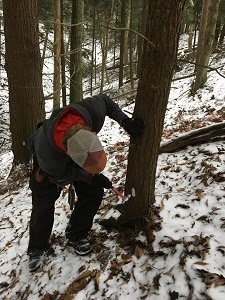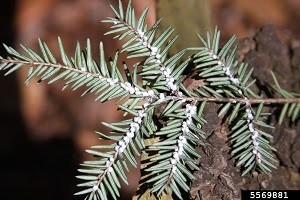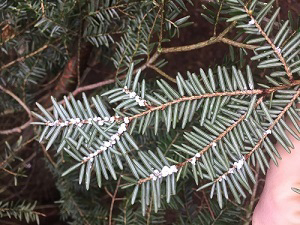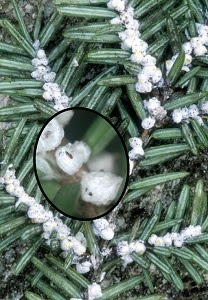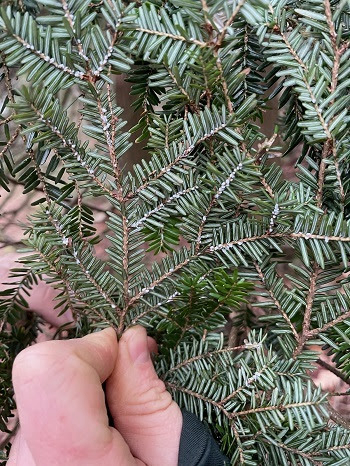Michigan: time to check trees for hemlock woolly adelgids
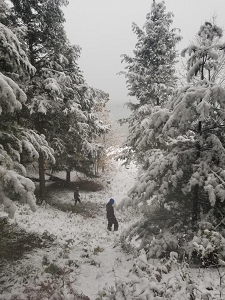
Invasive pest already confirmed in five southwest Michigan counties
Hemlock woolly adelgids, tiny invasive insects that suck nutrients from hemlock trees, are known to be present in Allegan, Ottawa, Muskegon, Oceana and Mason counties.
State agency staff, university researchers and regional cooperative invasive species management areas have been working to identify and contain infestations that span across public and private lands.
This winter, the Michigan departments of Natural Resources and Agriculture and Rural Development encourage those who have eastern hemlock trees on their property, whether in known infested counties or elsewhere, to take time to inspect the trees for signs of hemlock woolly adelgid.
If untreated, hemlock woolly adelgids can kill hemlock trees in four to 10 years. Trees can be protected with proper insecticide treatments.
Winter is the optimum time to look for evidence of an infestation, according to Robert Miller, MDARD’s invasive species prevention and response specialist.
“Cooler temperatures trigger feeding activity,” Miller said. “As hemlock woolly adelgids feed, they secrete a white, waxy material that creates ovisacs. The presence of these small, round, white masses makes it possible to identify infested trees.”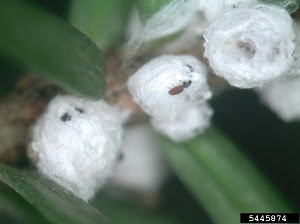
These insects are considered invasive because they are not native to the state and cause significant harm to Michigan’s hemlock resource. With no pressure from native predators or diseases, HWA populations continue to grow, threatening an estimated 170 million hemlocks across the state.
Winter surveys underway
| Again this winter, DNR and CISMA survey crews will be looking for signs of hemlock woolly adelgid on public and private lands within 5 miles of the Lake Michigan shoreline, the most probable area for new infestations.
Infested trees and any other eastern hemlocks within the area will be mapped and tagged, then prioritized for summer treatment. CISMAs will seek landowner permission to conduct surveys of hemlocks on private lands. CISMA survey efforts are supported by funds from the Michigan Invasive Species Grant Program and are provided at no cost to landowners. |
Your help is needed
Though crew members will cover a lot of ground, they won’t be able to check all trees. If you have eastern hemlocks on your property, take some time to look for signs of hemlock woolly adelgid. Anyone spending time outdoors is encouraged to do the same.
In Michigan’s northern forests, hemlock trees are found in moist soils along streams and riverbanks and along coastal dunes. Hemlock also is popular as a landscape tree in parks and residential areas.
Identify hemlock trees
Since adelgids feed and form ovisacs only on eastern hemlock trees in Michigan, it is important to distinguish hemlocks from other conifers like pines or spruces. Look for:
|
Look for signs
Late fall through early spring is the best time to check hemlock trees. Look on the undersides of branches for evidence of round, white ovisacs near the base of the needles.
Up close, ovisacs look like balls of spun cotton and may appear alone or in clusters. The short video “Hemlock woolly adelgid: Invasive species in Michigan” provides helpful identification tips.
Report your findings
| Report suspected hemlock woolly adelgid infestations through the Midwest Invasive Species Information Network, available online at MISIN.MSU.edu or as a downloadable smartphone app. The MISIN smartphone app will take a GPS location point if a report is made at the site; it also will allow you to upload photos with a report.
Reports also can be made by email to MDA-Info@Michigan.gov or by phone to the MDARD Customer Service Center at 800-292-3939. Identify the location of infested trees and, whenever possible, take one or two pictures of infested branches to help confirm identification. To avoid spreading the insect, do not collect sample branches or twigs. |
Manage your trees
If you find hemlock woolly adelgids on your property, it is important to know that certain insecticides are successful in treating the infestation if used correctly. A qualified arborist, such as one certified by the International Society of Arboriculture, can diagnose and assist with treating infested trees. Additional help is available through local cooperative invasive species management areas.
If you are able to handle treatment on your own, follow the guidance provided in the MSU Extension Bulletin: “How to treat hemlock trees for hemlock woolly adelgid.”
Reporting infested trees, even if you will be managing them on your own, is important to help determine how far hemlock woolly adelgid has spread. This information also indicates where additional surveys may be needed.
For more information on identification, reporting or treatment, visit the Michigan Invasive Species Program’s hemlock woolly adelgid page at Michigan.gov/HWA or contact Drew Rayner, DNR West Michigan hemlock woolly adelgid coordinator, at RaynerD1@Michigan.gov or 517-231-8763.


